Recent Articles
Original Thought in the Age of AI
Ever since the broad availability of artificial intelligence exploded last year, I’ve been wondering about its impact on B2 marketing. There is already a lot of “me-tooism” in much of B2G content marketing. Would AI make that even worse? Or could it, in fact, amplify the value of truly original insights for thought leadership? Or perhaps both?
A recent article by Tom Fishburne, aka The Marketoonist, articulates some thoughts on this question. While focused on SEO it’s wrestling with the same basic question. Titled “Writing and SEO Word Soup,” it talks about how since large language models (LLMs) are built on ingested content, if LLM-powered AI is used to generate “new” content then it quickly becomes just “word soup.” Fishburne quotes Jono Alderson, former head of SEO at Yoast:
“You are recursively optimizing a very small corpus until it’s all just word soup.“
Fishburne calls the temptation to turn your content development over to AI a “race to the bottom.” Unfortunately, I can see too many companies falling into this trap, humorously represented below:

While Fishburne focuses on the peril of word soup and “infinite words nobody wants,” I think that depressing vision also presents a huge opportunity for true insight and commentary. There’s an old expression, “In the land of the blind, the one-eyed man is king.” Similarly, if everyone else is regurgitating existing content, the B2G companies that are saying something new and different have a chance to differentiate themselves.
Of course, not every piece of content has to be a heavy lift. Plenty of content created for customers and prospects is straightforward in nature, like contract vehicles, partner information, and awards. Thought-leadership content requires some time and effort, but the payoff will be magnified in the age of AI if your competitors take the path of least resistance.
There are ways AI can support your content development strategy. My friend Janet Waring and her StoryTech partner agency ArtForm recently did a video on the topic that is time well spent. But you can’t take humans out of the equation. If your SMEs don’t have useful insights, your efforts to differentiate your company will fail.
Thanks to my old friend Mark Amtower for suggesting I subscribe to the Marketoonist newsletter. I signed up for the cartoons and stayed for the commentary. Maybe you will too.
Nuggets from GAIN 2023
Recently I attended the GAIN 2023 conference, an event dedicated to business-to-government (B2G) marketing. I’ve attended GAIN since it began in 2016, sponsored by Government Marketing University. In 2021 GovExec purchased GMarkU and produced this year’s event.
Attendance seemed strong and fully recovered from depressed pandemic levels. Many of the speakers and presentations were excellent. I can’t do the whole show justice, but here are some useful GAIN 2023 nuggets that stood out to me. Plus some links if you’d like to explore further.
The opening presentation was on Artificial Intelligence and how to use it to become a next-generation government marketer. Paul Roetzer of the AI Marketing Institute gave a talk that was a mixture of thought-provoking predictions and practical AI tips. Such as:
• ChatGPT is just the tip of iceberg. 80% of KW will be intelligently automated to some degree in 1-2 years.
• How to best start experimenting with AI? Problem-based vs. Use Case model. Problem-based is using AI to solve known pain point, use case is quick-win pilot project, must be data driven, repetitive, predictive and generative.
•There are so many new tools to try! ChatGPT now includes DALLE-3, Imagen, new AI features added to Zoom, Runwayml.com, descript.com, Microsoft CoPilot.
Well-known B2G practitioners Lisa Sherwin Wulf and Monica Mayk shared their perspectives on making the most of your B2G marketing resources and budget.
•Timelines and measures of B2B vs. B2G success are very different – align with Sales and Marketing on KPI from beginning, know corporate rules, operational vs. campaign funds, find money from other departments and projects – OPM stands for other people’s money
•Park money with partners and vendors
•Know your tech stack and KPIs
•Hire internal when you can, keep stable of freelancers and vendors
•Leverage corporate PMMs who want to learn PS
•Remember that industry expertise is costly but critical
Allan Rubin and Guy Timberlake shared a detailed methodology for understanding the federal buying journey. The 7-Step process from the Defense Acquisition University helps marketers know when to engage federal decision-makers with their content and differentiators.

•GET IN FRONT – if you wait until the opportunity is announced (RFP stage), you’re already at step 5
•Understand the DAU 7-Step process
•Become familiar with the Shipley Method
•Share informative, vendor-agnostic info throughout the entire process, builds trust and differentiates
Aaron Heffron then shared some research on the media habits of the public sector buyer. Aaron is, President of Research and Forecasting at GovExec, and formerly President of Market Connections before its purchase by GovExec in 2022. Most of the information was familiar to those who purchased the M4PS research earlier this year, but there were some interesting items.
•Drive time is back, and WTOP is #1
•Customer testimonials way down in credibility – not known was has caused this, perhaps poor quality or overuse?
•Newsletters are big in SLED
•66% feds listen to podcasts, up from 56% in 2022
•GovExec top digital site for 38% of civilian and 39% of Defense

Juliana Slye of B2G strategy firm GBR and Molly Tomevi of Carahsoft did a presentation on the Government Buyer’s Journey. Spoiler alert – it’s long.
•Something must first happen that knocks government out of status quo before it wants to make a purchase
•Process takes at least 12-18 months
•According to Forrester – 13 pieces of content consumed for a B2B purchase, 27 touchpoints for B2G
•A MQL does not become a SQL until step 16-17
•44% of millennials want a purely digital sales experience, no humans (Gartner)
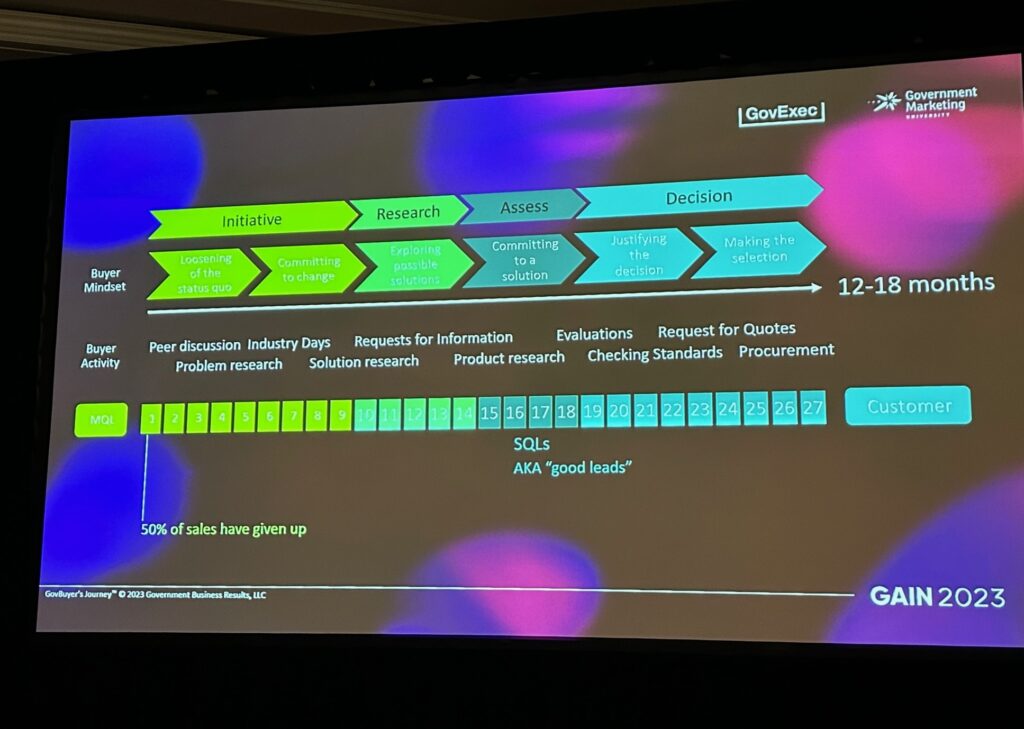
Finally, it wouldn’t be GAIN without a lot of networking with peers and prospects. Hope these nuggets are helpful and see you there next year!
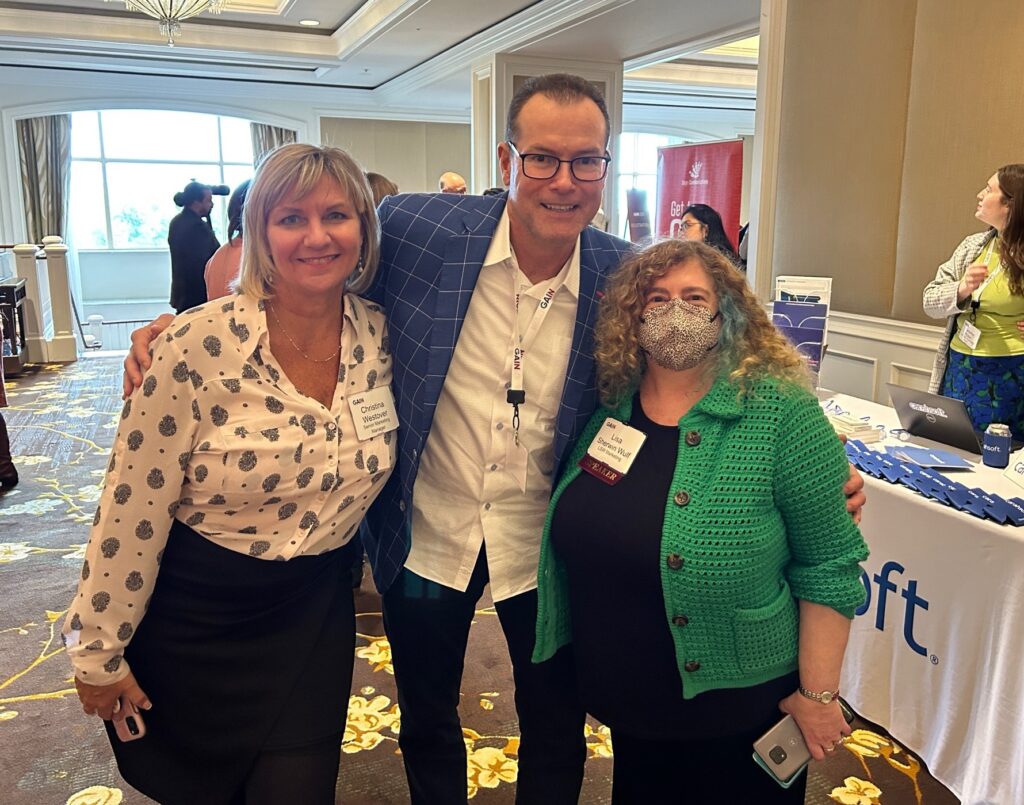
Government Marketing 2.0
There is a brand new book out called Government Marketing Best Practices 2.0, available on Amazon. I’m proud to say that I contributed a chapter in the book, along with a number of other government marketing experts.
Credit for the book goes to long-time government marketing expert and consultant Mark Amtower. Mark has written the original version years ago and knew it needed to be updated. He leveraged members of our weekly GovCon Ideation call and a few other B2G experts and assigned us each a chapter.
Mark describes the book this way:
Government Marketing Best Practices 2.0 is a collaborative effort among several leading government marketing experts. It is designed to provide both the novice and experienced GovCon marketer with strategies, tactics and tips to develop and execute successful marketing plans in the vast public sector arena. It will help all who read it to become better public sector marketers and to level up their game.
My chapter is titled “The Importance of Content Creation – Owned Media.” Here are the other chapters and authors – a veritable who’s who in the B2G space:
- Annual Strategic Planning: Stephanie Geiger
- Corporate Branding: Eileen Cassidy Rivera
- Thought Leadership in GovCon: Mark Amtower
- PR for GovCon: Joyce Bosc
- Association Involvement: Katie Helwig
- Positioning Your Digital Footprint for Growth: Janet Waring
- Events: Stephanie Geiger
- Webinars: Sheri Ascencio
- Developing a Marketing Campaign: Stacey Piper
- Email Marketing: Stacey Piper
- Pre-Programmatic Marketing: Why it Matters When you Are Trying to Win Government Proposals: Carl Dickson
- Marketing to the Intel Community: Larry Letow
- Creating Buzz and Building Relationships Through Events: Chelsea Meggitt
- LinkedIn and Social Selling: Mark Amtower
In my chapter I practice what I preach and try to answer the “Why?” question – why is this information important for the reader/visitor? I cover the many benefits of producing quality content – supporting organic SEO, powering the customer journey/sales funnel, supporting earned media efforts and giving some key performance indicators (KPIs) for measuring effectiveness. The chapter focuses on earned media in particular because it holds the most potential for differentiating from competitors long before prospects make contact directly.
Publication of the book was made possible by Government Market Press and Government Marketing University, which is a subsidiary of GovExec. On November 30th GovExec held a “Meet the Authors” event hosted at the headquarter of Maximus in Tysons Corner. It was fun to connect and network with my fellow contributors and answer questions from the audience. Connie Sayers, Chief Revenue Officer for GovExec acted as moderator.
One point I made during the panel discussion was how the blog post has become the ‘Rodney Dangerfield’ of government marketing content. It tends to get no respect at all. This is probably due to many companies putting out blog posts that are a far cry from high-quality.
But there is a disconnect I first pointed out last year when I participated in a panel looking at a public sector marketing study conducted by Market Connections. While blog posts are rank poorly by public sector decison-makers, the organic search results of potential vendors are ranked highly. Organic SEO depends heavily on producing a regular cadence of owned media, including blog posts.
As of this publishing date the book is available for the special early-bird price of $5. That price will go up soon. So if you need the perfect stocking stuffer for anyone involved in B2G you won’t find it anywhere. My thanks to my fellow contributors and to Mark and Connie. And watch for more titles coming from Government Market Press.
Merry New Year!
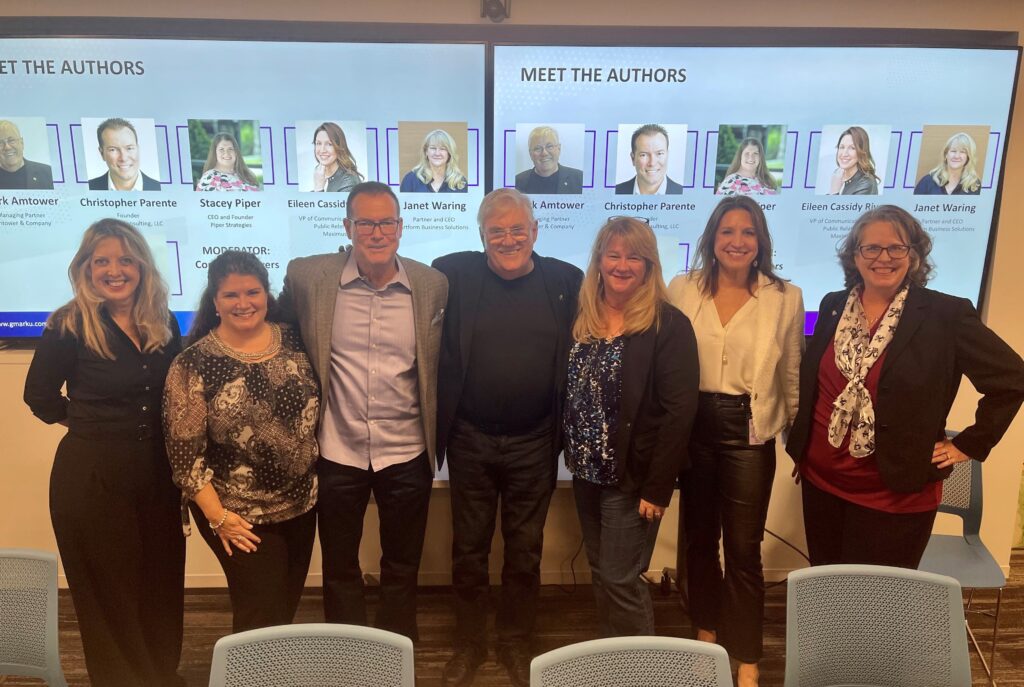
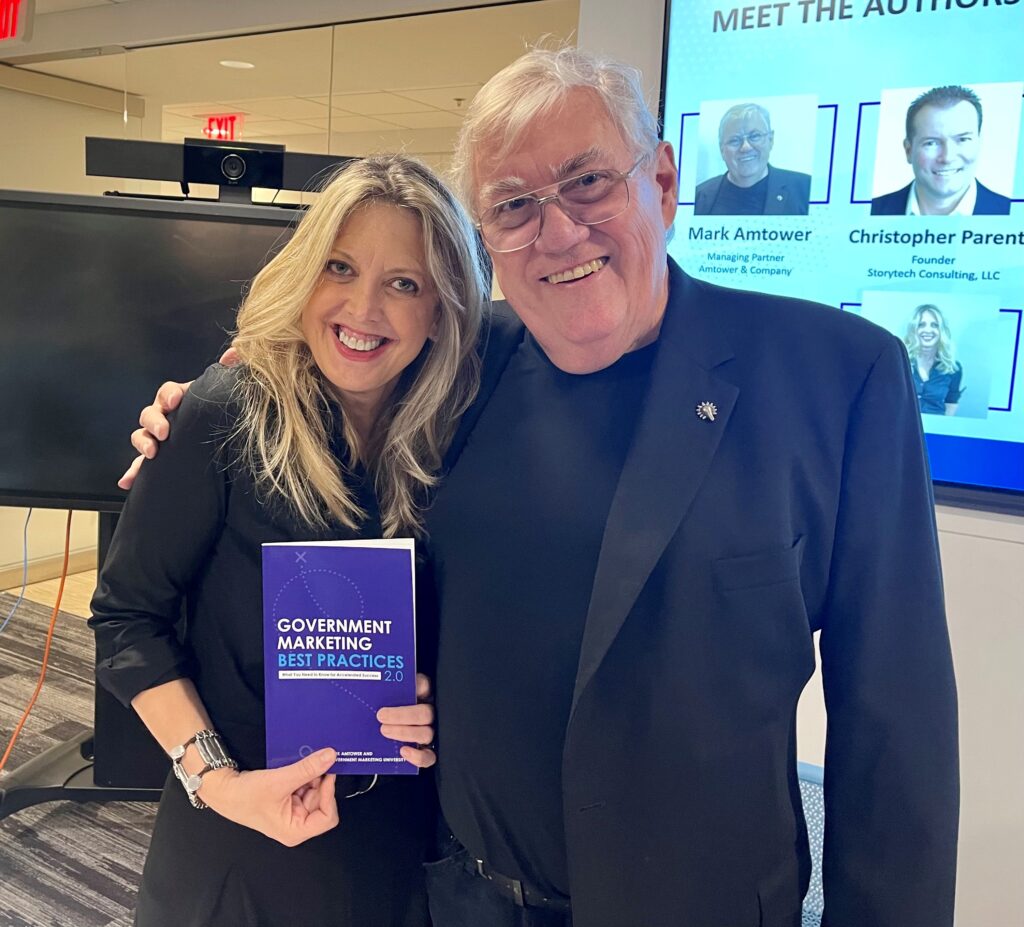
Mark Amtower Talks LinkedIn for Govies
Last week I attended an excellent presentation on the use of LinkedIn in the federal space. The presenter was Mark Amtower, known by many as the “Godfather” of government marketing. The discussion was a GovCon ClubTM event organized by Guy (Go-To-Guy) Timberlake, another long-time luminary in federal marketing.
When Mark Amtower talks LinkedIn people listen. He was among the first to recognize the potential of LinkedIn for government marketing. A leading author, radio show host and consultant for over 35 years in the federal market, he has been tracking the growing adoption of LinkedIn by government officials since 2009. His research and consulting have been driving forces in debunking the old conventional wisdom that “govies don’t use social media.”
That research was part of Mark’s first main point in the presentation. Federal marketers need to be on LinkedIn because that’s where the audience is – lots of them. There are 2.5 million currently on LinkedIn according to Mark’s latest annual census. The pandemic accelerated this growth – there are 551 distinct federal government organizations on LinkedIn, a number that doubled from 2021 to 2022.

Despite these numbers only a small percentage of government marketers use LinkedIn effectively to build their brand. Mark talked about how important is it to define your skills and then demonstrate those skills via a quality profile page. Common fails include not using a personalized background, not having a quality headshot and not leveraging the profile headline and the About section to clearly communicate skills and passion.
Two strong examples cited by Mark are Carl Dickson and Carey Bandler. Carl has achieved thought leadership around winning federal contracts, while Carey brands himself as a “Federal CXO Whisperer” in his profile headline.
Next Mark talked about what I call the “perspiration” rule – you need to publish quality content on a regular basis. People used to talk about not letting websites get “cobwebs;” the same is true with your LinkedIn presence. Sharing good content enhances your credentials and differentiates you in the market. It doesn’t always have to be original, you can comment and react to other people’s content – just like I’m doing here!
Success Story
Mark shared how our mutual friend Chelsea Meggitt leveraged LinkedIn to maximize her presence at the recent SOFIC show in Tampa, Florida. Chelsea started promoting the show itself and her attendance four weeks out. She kept this up weekly, and then posted coverage each day of the event. She shared post-event wrap-up content, and tagged people and organizations every step of the way.
The response was amazing. Some of her posts went viral, with her #badasswomenindefense post getting over 8,000 views in one day. Some other results – this type of LInkedIn use should be required reading for anyone looking to get the most out of “just walking the floor” at a show:

Everyone learned something new about LinkedIn from the presentation. I’m a regular LinkedIn user but I was behind on using the QR code to quickly connect with someone in person. I also learned that users of the mobile LinkedIn app can now personalize a connection invite. This is good to know because I always look for a personalized note when getting an invite from someone I don’t know. In the past I’ve wondered if I was discriminating against mobile users who couldn’t personalize.
As Mark will tell you most of this isn’t rocket science. I call it 20 percent inspiration and 80 percent perspiration. It’s doing the small things consistently, like thanking people for comments, recognizing others in the space, responding to issues relevant to B2G marketing and consistently demonstrating expertise through quality content.
Those who can commit to LinkedIn put themselves in position to be much more successful in GovCon marketing. The next time Amtower talks LinkedIn I suggest you register. Or contact him about getting your whole company or team schooled up on using LinkedIn to differentiate and win.
GovExec and the New B2G Model
Last week Tim Hartman and Frank Salatto were guest speakers on our Ideation group govcon call. Tim is Chief Executive Officer of GovExec, and Frank is SVP and Head of Growth Initiatives. They gave us a compelling overview of GovExec’s string of acquisitions over the past two years, arguably the most important development for B2G marketing in recent years. Disclosure – StoryTech Consulting has worked for GovExec as a subcontractor in the past.
Tim laid out how GovExec is building a market intelligence platform to replace the “old” model of B2G marketing. (GovExec is the new brand name of the parent company, while Government Executive lives on as the flagship publication.) The old model of B2G marketing was dominated by incumbent defense contractors and management firms staff with employees with deep personal relationships with government decision-makers. This model worked for many years, and Tim noted it still can work today. B2G success is still driven by personal relationships and face-to-face marketing.
The new B2G model emerged about 10 years ago and focuses far more on intelligence-driven marketing that directly targets identified opportunities. This new model was used by Silicon Vally companies as they entered the B2G market in a big way. Almost a decade ago then underdog AWS beat out IBM for a CIA cloud computing contract, which Tim called the wake-up moment for this new model. Since being purchased by private equity firm Growth Catalyst Partners in 2020, GovExec has made a string of acquisitions to better support this new B2G model.
Since then GovExec has made 11 acquisitions, consolidating the B2G media and marketing world to an unprecedented degree. The graphic above shows the three GovExec solution areas – Data Intelligence, Campaign Platform/Content and Marketing/Full Funnel services. All the acquisitions in the past two years bolster one of these solution areas.
Tim mentioned the purchases of GovTribe, The Atlas for Cities and research firm Market Connections for business intelligence. City and State New York deepened GovExec’s reach into state and local audiences. The huge splash was last summer when GovExec purchased 1105 Media’s Public Sector 360, combining Federal Computer News, Government Computer News, Washington Technology, Defense Systems, and the Fed 100 with existing brands Government Executive, NextGov, Defense One, Route 50 and City and State. Never before have so many media brands focused on government been controlled by the same company.
Tim and Frank spent less time on the marketing services side. Some of those services derive from GovExec’s database of contacts, built up constantly through traffic that exceeds 1.5 million unique monthly visitors to their online brands. The acquisitions of Government Contracting Institute and Government Marketing University should also play roles down the road in additional offerings.
GovExec is building a one-stop shop for government marketers. They will identify the opportunities, connect a client’s content with the right decision-makers, then help nurture and convert the leads. So what’s the next acquisition? Tim wasn’t sharing any secrets on that front, but he did allow that GovExec is only in the “third inning” of its evolution.
As a long-time B2G content marketer I’m fascinated by what GovExec is building. A few years ago a hot topic in B2G circles was the debate around who offered more to B2G clients – legacy publishers or marketing firms that built publishing organizations? By consolidating the market to such a degree GovExec seems to have answered that question.
As a fan of quality content that informs and enlightens I’m also glad that GovExec seems to have found the right private equity owner. To many PE firms purchase media companies and then strip them down and sell them for parts. Since engaging with decision-makers is so central to the vision being built I’d expect editorial excellence will be protected.
Partisan combat and Congressional approval ratings aside, government has never been more essential to address our nation’s challenges. Many private companies need help understanding the nuances of selling to government. If GovExec’s vision for B2G marketing puts the right solutions to work for government clients to achieve the mission, then GovExec will do well by doing good.
Ideation Call Research Sharing
The COVID pandemic has deepened my relationships in the GovCon community. Early in 2020 the Ideation call was set up by Government Marketing University. As many as 70 government marketers would Zoom in and share tips and best practices as we all groped for a new normal. It was both a professional and a psychological lifeline as we negotiated those early and uncertain days.
We continue to meet every Tuesday morning. While the number of participants has leveled off, a core group continues to share valuable information and research relevant to B2G marketing. I’m proud to say that I now co-chair the group, along with Mark Amtower of Amtower and Associates, and Janet Waring of ArtForm Business Solutions. The Ideation call has created one of most active and valuable “communities of interest” under the GMarkU umbrella.
Two recent presentations demonstrate the value of Ideation call information sharing. Mark presented on his annual census of government officials on LinkedIn, and Kelly Waffle of Hinge Marketing shared some results of a study on the characteristics of high-growth government contractors.
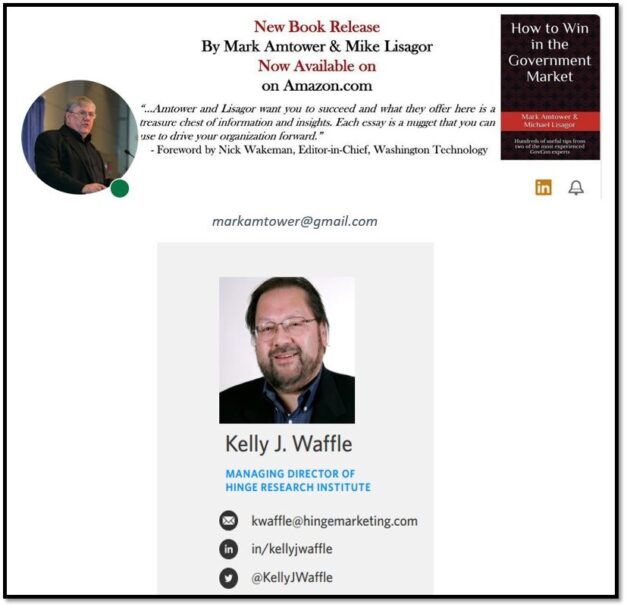
The Presenters
No one knows more about LinkedIn use in the government space than Mark Amtower. Since 2013 he has tracked the growing adoption of LinkedIn by government officials. He has been a driving force in debunking the old convention wisdom that “govies don’t use social media.”
Mark told us that he uses the U.S. Government Manual and USA.gov to identify all federal agencies. Across the board the pandemic has driven more government employees to use LinkedIn. The DoD was ahead on this front, with the growth more prominent on the civilian side. The number of agencies with company pages on LinkedIn almost doubled from 2021 to 2022.

The census with exact LinkedIn numbers for 551 distinct federal government organizations is available for just $99. Ping Mark on LI, or I’d be happy to broker an introduction.
Kelly Waffle heads up the Hinge Research Institute. Hinge Marketing is a well respected firm focused on supporting professional services clients. They put out an annual report focused on high-growth companies across a range of industries and firm sizes. Kelly shared with us some findings on 135 participating government contractors, representing almost $52B in revenue.
Compared with other industries overall GovCon growth slowed in 2021, averaging 10.6 percent. Within the GovCon category the differences were stark – high-growth companies averaged a 26 percent increase in revenue, while no-growth companies saw revenue decline an average of 7 percent. Kelly shared insight into four main areas in which high-growth companies outperform their fellow GovCons:
- Talent
- Technology
- Marketing
- Strategy
One specific nugget is high-growth companies put far more emphasis on social media and search engine optimization (SEO) than slower-growing firms. I’ve seen this first hand – there is a lack of appreciation of the importance of SEO among many contractors. Things are starting to change, but B2G has been slower here than B2B.
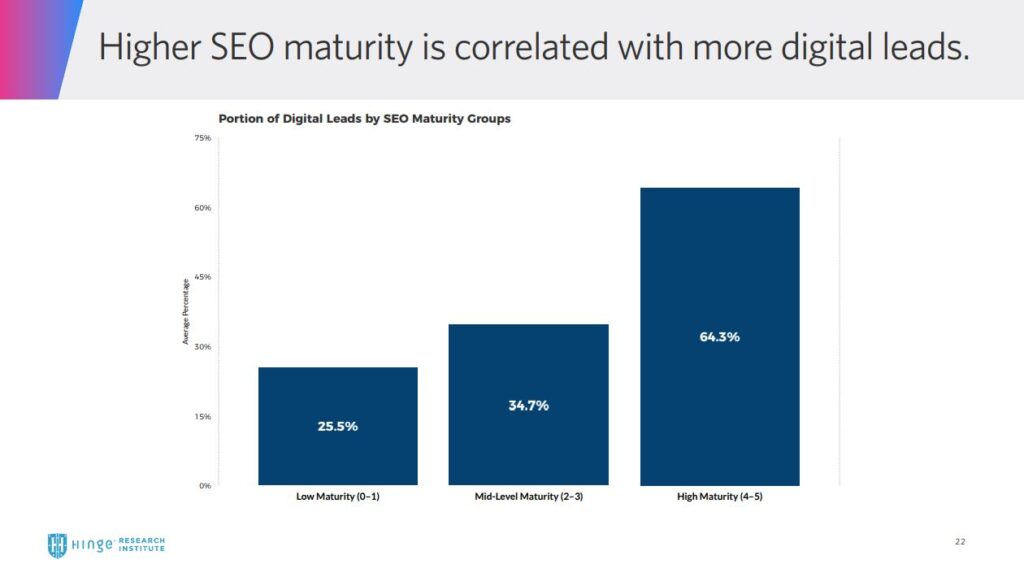
Other recent sessions have ranged from the strategic – understanding upcoming privacy legislation, trying to understand where CMMC is going – to the tactical – leveraging UTM codes to the fullest and quickly creating infographics. If you’re in B2G and are interested in attending, here’s the Zoom registration link.
Zoom can’t replace in-person collaboration. No one wants physical events to restart more than me, especially the upcoming GAIN conferences. But the relationships and the skills honed by the Ideation call community have been a godsend these past two years.
Public Sector Content Marketing Study
Last month I was a panelist for a public sector content marketing study conducted by Market Connections. Market Connections is a highly respected research firm focused on B2G and B2B markets and I was honored to be on their panel of experienced content creators.
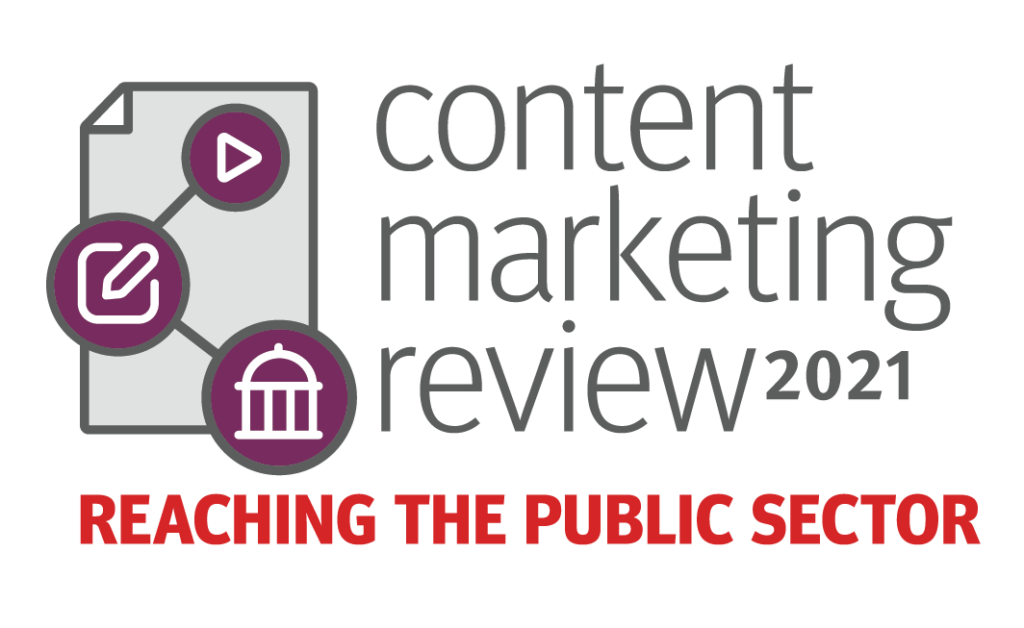 Market Connections polled over 600 government decision-makers at federal, state and local agencies and with K-12 and higher education institutions around the country. Respondents were evenly split between the three government levels. There are so many formats content can take, and it’s critical to understand what types of marketing assets public sector decision makers find most useful.
Market Connections polled over 600 government decision-makers at federal, state and local agencies and with K-12 and higher education institutions around the country. Respondents were evenly split between the three government levels. There are so many formats content can take, and it’s critical to understand what types of marketing assets public sector decision makers find most useful.
There were two panels for the webinar, one with content creators and one with public sector marketers. That panel discussion was moderated by Aaron Heffron, President of Market Connections. The panelists were Monica Mayk of Verizon Business, Betsey Morrow of Amazon Web Services and Preston Smith from Cisco.
My panel was moderated by Lou Anne Brossman, Founder and CEO of Government Marketing University and I’m proud to say an old friend. Also on the panel was Matt Donovan, SVP at the Merritt Group, which was a sponsor of the study and webinar. We shared out thoughts on the findings and tried to add some additional insights.
Often there can be a disconnect between the content marketers want to provide and the content decision-makers want to consume. Such a disconnect was uncovered by a Market Connections report in 2015.
Across all public sector respondents valued content that aligned with their interests. Matt and I both thought of customer personas when we saw those results, and a validation of how valuable they can be when crafting thought-leadership content. Those personas in turn then become foundational resources for account based marketing (ABM) campaigns.
Data and research, trials/demos and proof of past performance content also ranked highly in the study. Matt and Lou Anne both referred to this as “show me” rather than “tell me” content that was especially important for federal decision-makers. I agreed, but pointed out that type of content is lower down in the sales funnel and gated. You need to educate at first and can’t go for the close too early in your content, especially when an estimated 75 percent of the sales process is done before a prospect ever makes contact – the so-called Dark Funnel.
We also noted the widely different rankings for white papers vs. eBooks, thinking it might be a semantic difference. As marketers we viewed eBooks simply as a shorter, more visually appealing version of a white paper but the term seems to have a branding problem with public sector audiences. This being the case I’m going to advise my clients to expand their definition of the term white paper and use that term in general for their longer form content.
I detected what might be a disconnect in the disparate rankings of SEO and blog posts. SEO relevance was ranked highly while blog posts were not. While blog posts may have ranked lower on content type for respondents when looking to educate themselves for purchasing decisions, government marketers cannot ignore their blogs. That’s because blogs are a key part of an owned media strategy that help company content achieve a strong organic SEO ranking.
Each finalist was asked to share just one useful and tactical tip. Mine was a reminder about using the Audience Interests data in Google Analytics to guide your content development. Simply going to Audiences/Interests/Affinity Categories will provide valuable data on the kind of visitors visiting your site, and the kind of content they want from you.
The research report is available for purchase here. It’s only $199 and worth every penny.

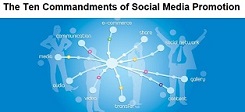 Do you know how to market your expertise via social media channels? See below to download The Ten Commandments for Social Media Promotion.
Do you know how to market your expertise via social media channels? See below to download The Ten Commandments for Social Media Promotion.